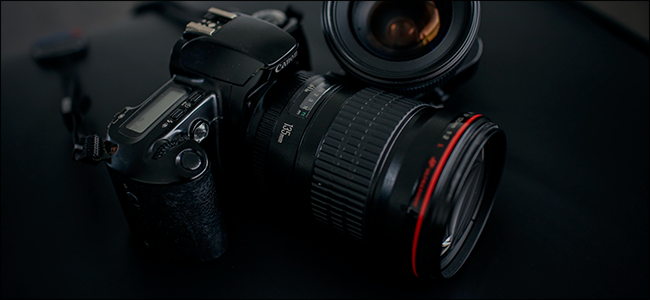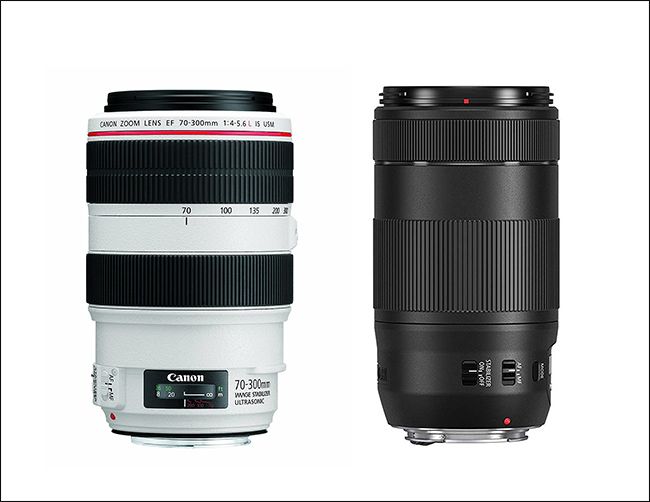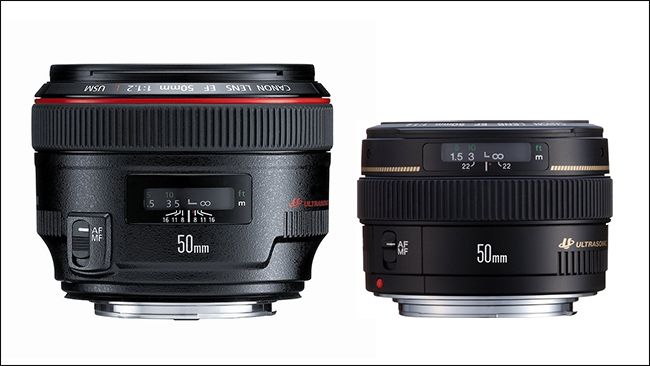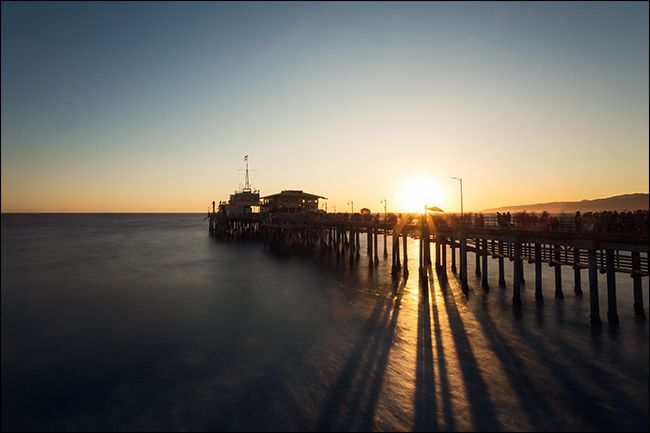Quick Links
Canon sells regular and L-series lenses (the "L" stands for luxury). While the lenses may have similar specs, you can usually except L-series lenses to have better optics, build quality, and autofocus control, and a few more features. Let's take a look.
While there are great, affordable, Canon lenses available, you’ve probably seen lenses that have similar specs on paper but wildly different prices. For example, the Canon EF 70-300mm f/4-5.6 IS II USM lens is $449 while the similar-sounding Canon EF 70-300mm f/4-5.6L IS USM UD is $1,349. They have the same focal range and aperture, so what's different about the regular and the L-series lens that makes one worth so much more?
Canon’s lenses come in two categories: non-L lenses and L-series lenses. The “L” in L-series doesn’t actually mean very much; it just stands for luxury. If the name of the lens has an L in it after the aperture value, it’s an L-series lens. If it doesn’t, it isn’t. You can also tell from the design of the lens. L-series lenses have a red ring around the top and the telephotos are white; regular lenses are just black.
L-series lenses are Canon’s professional lenses; they’re designed to meet the needs of working photographers, although plenty of amateurs also own L lenses. This means that there are a number of factors that—generally—differentiate them from cheaper non-L lenses even if they have the same focal length or aperture.
Better Optical Quality (Normally)
L-series lenses generally have better optical quality than non-L lenses. There are one or two examples of some non-L prime lenses having similarly good optics, but across the board and in like-for-like comparisons, L lenses win handily.
This means there’s less distortion, chromatic aberration, vignetting, lens flare, and the like. Photos will also be sharper right out of the camera. Basically, the images produced by an L lens will be noticeably better—at least to someone who knows what to look for—than images produced by a non-L lens.
L lenses also tend to have faster apertures than non-L lenses. Canon’s fastest 50mm is the f/1.2L; the fastest non-L 50mm they offer is the f/1.4. You won’t find a non-L telephoto lens with an aperture wider than f/4; the 70-200mm f/2.8L IS II is one of the most popular L-lenses around.
Better Build Quality
Canon’s L-series lenses have better build quality than their non-L counterparts. The higher quality optics mean they’re bigger and heavier (the 50mm f/1.2L weighs 1.28lbs while the 50mm f/1.4 weighs 0.64lbs); they also use premium materials. Many non-L lenses make heavy use of plastic components, while L lenses tend to use a lot more metal. This means that the majority of them are pretty rugged and, to some degree, weather sealed. Dust, rain, sand, and the like are far less likely to get into the mechanisms or between the glass elements and mess things up.
Better Autofocus and Focus Control
L-series lenses have better autofocus and focus control than non-L lenses. Their autofocus tends to be faster and more accurate. They also have full-time manual focus (even in autofocus modes you can twist the focus ring to adjust) and focus distance scales on the lens, which a lot of non-L lenses lack.
Full Frame Support
All Canon’s L-series lens are compatible with their EF mount full frame cameras. A huge number of non-L lenses use Canon’s EF-S mount, which means they can only be used on crop sensor cameras. There are non-L EF mount lenses, but there are no L-series EF-S mount lenses.
The Same Filter Size
Where possible, Canon’s L-series lenses all share the same filter size: 77mm. This means you can easily share filters—such as neutral density filters or polarizers—between all your lenses. There are a few L-series lenses that, due to their optical design, have a different filter size but they’re all far more consistent than non-L lenses.
Should You Buy L-Series Lenses?
By now it should be pretty clear that L-series lenses have a few marked advantages over non-L lenses: they capture better images, are better built, and give you more control over what’s in focus. This doesn’t mean you should rush out and replace all your lenses with the most expensive bit of glass you can find, though.
Your skill as a photographer matters far more than the lens you are using. If your photos aren’t well composed , it doesn’t matter if they’re perfectly sharp. No one looks at a boring photo and goes, “Ah, edge to edge sharpness; great work!”
L-series lenses are expensive. The cheapest L lens you can buy is the Canon EF 17-40mm f/4L USM for $749, and the prices only go up from there. You can get some great glass for a lot less than that. In fact, unless you have a full frame camera, you won’t even be able to make the most of the 17-40 f/4L. You’d be much better off with the $279 Canon EF-S 10-18mm f/4.5-5.6, which will actually give you the wide angle images you’re looking for.
L-series lenses are designed for working photographers who view new gear as an investment in their business. Unless you like to shoot in rough conditions, you don’t need weather sealed lenses. If you’re missing focus because you’re not using your autofocus correctly, a sharper lens isn’t going to help you. There are certainly big advantages to L-series lenses, but the average photographer won’t need them or notice them.
Image Credit: William on Unsplash.




